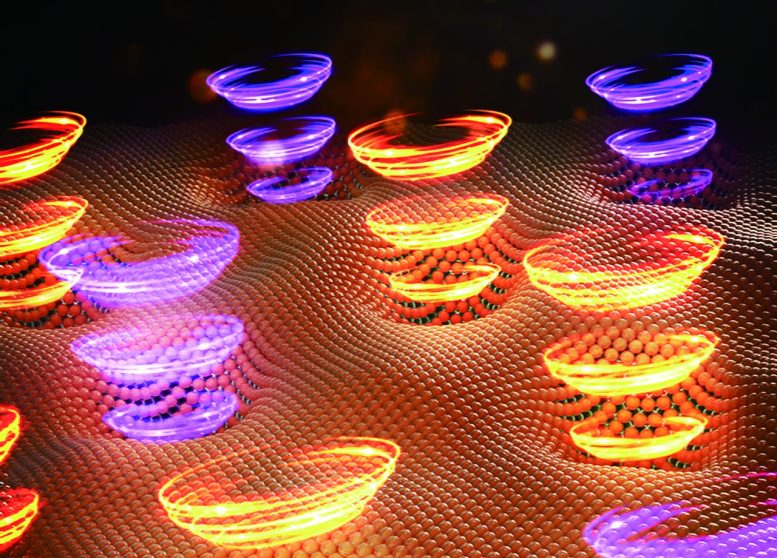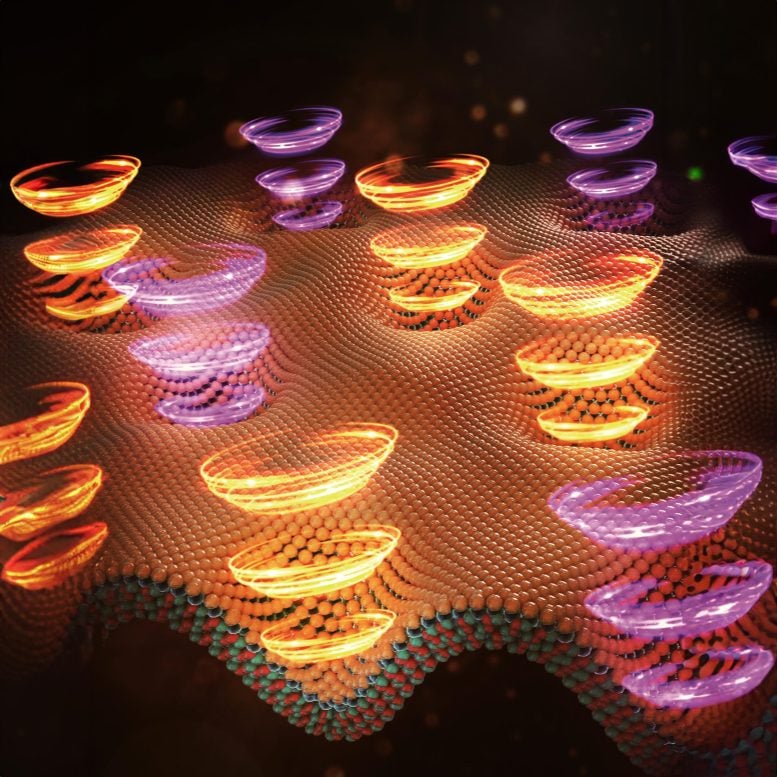
New approach is a step toward using single photons in quantum communication and information processing.
Researchers at the Los Alamos National Laboratory have developed a novel technique to generate a stream of circularly polarized single photons, crucial for quantum information and communication. Using atomically thin materials, they’ve shown that a monolayer semiconductor can emit circularly polarized light without an external magnetic field. The research team utilized nanometer-scale indentations to achieve this, resulting in a crucial step towards quantum cryptography, communication, and the potential for a hyper-secure quantum internet.
Revolutionary Quantum Light Emitters
A team of scientists at Los Alamos National Laboratory team stacked two different atomically thin materials to realize a chiral quantum light source. This new approach to quantum light emitters generates a stream of circularly polarized single photons, or particles of light, that may be useful for a range of quantum information and communication applications.
“Our research shows that it is possible for a monolayer semiconductor to emit circularly polarized light without the help of an external magnetic field,” said Han Htoon, scientist at Los Alamos National Laboratory. “This effect has only been achieved before with high magnetic fields created by bulky superconducting magnets, by coupling quantum emitters to very complex nanoscale photonics structures or by injecting spin-polarized carriers into quantum emitters. Our proximity-effect approach has the advantage of low-cost fabrication and reliability.”
The polarization state is a means of encoding the photon, so this achievement is an important step in the direction of quantum cryptography or quantum communication.
“With a source to generate a stream of single photons and also introduce polarization, we have essentially combined two devices in one,” Htoon said.

Indentation Key to Photoluminescence
As described in a paper published in the journal Nature Materials, the research team worked at the Center for Integrated Nanotechnologies to stack a single-molecule-thick layer of tungsten diselenide semiconductor onto a thicker layer of nickel phosphorus trisulfide magnetic semiconductor. Xiangzhi Li, postdoctoral research associate, used atomic force microscopy to create a series of nanometer-scale indentations on the thin stack of materials. The indentations are approximately 400 nanometers in diameter, so over 200 of such indents can easily be fit across the width of a human hair.
The indentations created by the atomic microscopy tool proved useful for two effects when a laser was focused on the stack of materials. First, the indentation forms a well, or depression, in the potential energy landscape. Electrons of the tungsten diselenide monolayer fall into the depression. That stimulates the emission of a stream of single photons from the well.
The nanoindentation also disrupts the typical magnetic properties of the underlying nickel phosphorus trisulfide crystal, creating a local magnetic moment pointing up out of the materials. That magnetic moment circularly polarizes the photons being emitted. To provide experimental confirmation of this mechanism, the team first performed high magnetic field optical spectroscopy experiments in collaboration with National High Magnetic Field Laboratory’s Pulsed Field Facility at Los Alamos. The team then measured the minute magnetic field of the local magnetic moments in collaboration with the University of Basel in Switzerland.
The experiments proved that the team had successfully demonstrated a novel approach to control the polarization state of a single photon stream.
Encoding Quantum Information
The team is currently exploring ways to modulate the degree of circular polarization of the single photons with the application of electrical or microwave stimuli. That capability would offer a way to encode quantum information into the photon stream.
Further coupling of the photon stream into waveguides — microscopic conduits of light — would provide the photonic circuits that allow the propagation of photons in one direction. Such circuits would be the fundamental building blocks of an ultra-secure quantum internet.
Reference: “Proximity-induced chiral quantum light generation in strain-engineered WSe2/NiPS3 heterostructures” by Xiangzhi Li, Andrew C. Jones, Junho Choi, Huan Zhao, Vigneshwaran Chandrasekaran, Michael T. Pettes, Andrei Piryatinski, Märta A. Tschudin, Patrick Reiser, David A. Broadway, Patrick Maletinsky, Nikolai Sinitsyn, Scott A. Crooker and Han Htoon, 17 August 2023, Nature Materials.
DOI: 10.1038/s41563-023-01645-7
Funding: Laboratory Directed Research and Development (LDRD) program at Los Alamos National Laboratory; the U.S. Department of Energy Basic Energy Sciences, QIS Infrastructure Development Program; and the Quantum Science Center, a national QIS Research Center supported by the DOE Office of Science.
Never miss a breakthrough: Join the SciTechDaily newsletter.
1 Comment
That capability would offer a way to encode quantum information into the photon stream.
Do you really understand the physical essence of quantum and photons?
Low dimensional spatiotemporal matter is the basic underlying structure of high-dimensional spatiotemporal matter. So far, relativity and quantum mechanics are the most successful theories for describing the essence of spacetime. If the quantum and photon you observe are high-dimensional spatiotemporal matter, rather than low-dimensional spatiotemporal matter, then using quantum mechanics and relativity to explain certain characteristics of the quantum and photon may confuse people and potentially fall into the quagmire of pseudoscience.